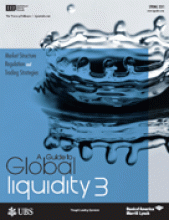Abstract
Leading investment professionals from BNY Mellon Asset Management discuss structural differences in equity and fixed income markets that affected the ability to transact during the 2008 crisis. They focus on the key role that transparency, information credibility, counterparty knowledge, and trade size can play in preventing a temporary liquidity squeeze from freezing up entire markets. Understanding the structural drivers of liquidity shocks in different markets and the self-reinforcing process that escalates those shocks may help managers develop better safeguards for managing liquidity.
- Copyright © 2011 The Bank of New York Mellon Corporation. All rights reserved. Not to be reproduced of redistributed without permission.
Don’t have access? Register today to begin unrestricted access to our database of research.








